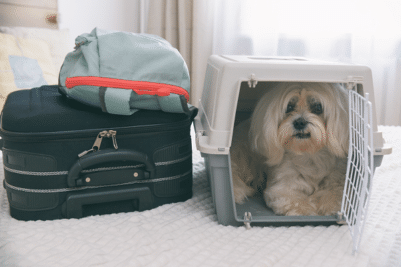September 19-25th marks Deaf Dog Awareness Week.
This initiative was started by PetFinder to spread awareness about owning a deaf dog. Although temporary, partial, or full (both ears) deafness can affect many dogs, they still make warm, caring companions and trainable pets.
What Causes Deafness in Dogs?
Severe and permanent deafness in dogs is caused by many of the same factors that cause deafness in humans, including injury to the ear, genetic defects, and old age. Dogs may also experience temporary hearing loss due to wax build-up in their ear canals. Certain breeds are more susceptible to wax build-up because they have narrower ear canals and more fur around, and in their ears.
If you notice that your dog is less responsive to your calls, or no longer comes running to familiar sounds (doorbell, or food pouring into a dish), it’s time for a professional veterinary assessment. Your veterinarian can examine your dog’s ears to detect any blockages, wax accumulation, injuries, and/or infections that may be affecting your dog’s hearing.
Caring For a Deaf Dog
Communicating with a deaf dog can be a challenge, but the following techniques can be used to help owners communicate with them:
- Train your pet to recognize hand signals instead of voice commands.
- Use a heavy stomp of the foot on the floor when you need to get your dog’s attention – they can often feel the vibration in the floor.
- To avoid startling your dog, gently tap or pet her to announce your entrance or exit from the room.
- Avoid letting your deaf dog wander alone outside, unless you have a fenced yard. There are obvious dangers with your dog being anywhere near traffic or other hazards that she won’t be able to hear.
- Consider attaching a bell to your dog’s collar. This makes it easier to locate your dog quickly in the house or in the event of an escape. Your dog won’t be able to hear your calls to come back, but you will be able to hear her.
- Be sure that all of your collars have an alert that your dog is deaf.
Your Responsibility in Preventing Deafness
Although some forms of deafness in dogs cannot be prevented or treated, there are actions you can take as a pet owner to help your dog avoid temporary or avoidable forms of hearing loss. Be sure to monitor your dog’s ears for wax and hair build-up. Your veterinarian can help clear the ear passages and allow your dog to hear properly.
At the first signs of any hearing impairment, take your dog to the vet. Your dog may have an infection of the ear canal that needs to be properly assessed, diagnosed, and treated, in order to prevent permanent damage.
Deaf dogs require attention, support, and love. Despite their hearing loss, deaf pets can read our body language and pick up on a variety of other sensory cues.
In honor of Deaf Dog Awareness Week, let’s celebrate the devoted owners of deaf dogs who enjoy a rich and rewarding relationship with their pets.
LifeLearn News
Note: This article, written by LifeLearn Animal Health (LifeLearn Inc.) is licensed to this practice for the personal use of our clients. Any copying, printing or further distribution is prohibited without the express written permission of Lifelearn. Please note that the news information presented here is NOT a substitute for a proper consultation and/or clinical examination of your pet by a veterinarian.













